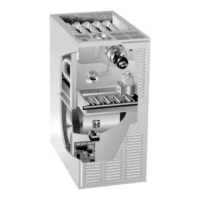Page 18
TABLE 8
CAPACITY OF TYPE B DOUBLE-WALL VENT WITH SINGLE-WALL METAL CONNECTORS
SERVING TWO OR MORE CATEGORY I APPLIANCES - VENT CONNECTOR CAPACITY
Vent and Connector Diameter - D (inches)
en
Hei
ht
onnec
or
Rise
3 Inch 4 Inch 5 Inch 6 Inch
H
R
Appliance Input Rating in Thousands of Btu Per Hour
(feet) (feet)
MIN MAX MIN MAX MIN MAX MIN MAX
1 NR NR NR NR NR NR NR NR
6
2 NR NR NR NR NR NR 168 182
3 NR NR NR NR 121 131 174 198
1 NR NR 79 87 116 138 177 214
15
2 NR NR 83 94 121 150 185 230
3 NR NR 87 100 127 160 193 243
1 47 60 77 110 113 175 169 278
30
2 50 62 81 115 117 185 177 290
3 54 64 85 119 122 193 185 300
TABLE 9
CAPACITY OF TYPE B DOUBLE-WALL VENTS WITH SINGLE-WALL METAL CONNECTORS
SERVING TWO OR MORE CATEGORY I APPLIANCES - COMMON VENT CAPACITY
Common Vent Diameter - D (inches)
en
Hei
ht
4 Inch 5 Inch 6 Inch 7 Inch
H
Appliance Input Rating in Thousands of Btu Per Hour
(feet)
FAN + FAN FAN + NAT FAN + FAN FAN + NAT FAN + FAN FAN + NAT FAN + FAN FAN + NAT
6 89 78 136 113 200 158 304 244
8 98 87 151 126 218 173 331 269
10 106 94 163 137 237 189 357 292
15 121 108 189 159 275 221 416 343
20 131 118 208 177 305 247 463 383
30 145 132 236 202 350 286 533 446
Removal of Unit from Common Vent
In the event that an existing furnace is removed from a
venting system commonly run with separate gas apĆ
pliances, the venting system is likely to be too large to
properly vent the remaining attached appliances. The folĆ
lowing test should be conducted while each appliance in
operation and the other appliances not in operation reĆ
main connected to the common venting system. If the
venting system has been installed improperly, the system
must be corrected as indicated in the general venting reĆ
quirements section.
1 - Seal any unused openings in the common venting
system.
2 - Visually inspect the venting system for proper size and
horizontal pitch. Determine there is no blockage or reĆ
striction, leakage, corrosion, or other deficiencies which
could cause an unsafe condition.
3 - To the extent that it is practical, close all building doors
and windows and all doors between the space in
which the appliances remaining connected to the
common venting system are located and other spaces
of the building. Turn on clothes dryers and any apĆ
pliances not connected to the common venting sysĆ
tem. Turn on any exhaust fans, such as range hoods
and bathroom exhausts, so they will operate at maxiĆ
mum speed. Do not operate a summer exhaust fan.
Close fireplace dampers.
4 - Follow the lighting instructions. Place the appliance
being inspected in operation. Adjust thermostat so apĆ
pliance will operate continuously.
5 - Test for spillage of flue gases at the draft hood relief
opening after 5 minutes of main burner operation. Use
the flame of a match or candle, or smoke from a cigaĆ
rette, cigar or pipe.
6 - After determining that each appliance remaining conĆ
nected to the common venting system properly vents
when tested as indicated in step 3, return doors, winĆ
dows, exhaust fans, fireplace dampers and any other
gasĆburning appliance to their previous condition of
use.
7 - If improper venting is observed during any of the
above tests, the common venting system must be corĆ
rected. The common venting system should be reĆ
sized to approach the minimum size as determined by
using the appropriate tables in appendix G in the curĆ
rent standards of the National Fuel Gas Code ANSI
Z223.1 in the USA, and the appropriate Category 1
Natural Gas and Propane appliances venting sizing
tables in the current standards of the CAN/CGA
B149.1 and B149.2 in the Natural Gas and Propane
Installation Code in Canada.

